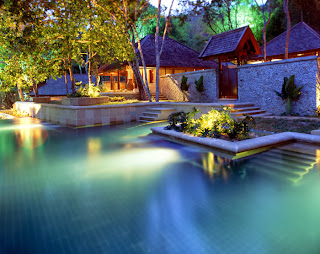Pulau Tioman, a giant apostrophe
shaped island situated in the South China Sea, is the largest island off the
east coast of Peninsular Malaysia. The island, which is located in the
Malaysian state of Pahang, once served as an important stopover point for
sailors, fishermen and traders who habitually refueled and restocked their
supplies on the island before continuing their onward journeys.
Today, the island is home to several village communities and is a popular destination with divers, snorkelers, sun worshippers and island hoppers. Pulau Tioman, hence accordingly hosts a wide range of accommodation options on its many beautiful beaches. However, in order to protect and preserve its rather fragile marine ecosystems, Pulau Tioman and its eight surrounding islands have been classified as a wildlife reserve. The island and its environs received this classification in 1972, as the Malaysian government wanted to ensure that the island’s native marine flora and fauna would not be disturbed or destroyed by tourism, fishing and other human activities.
Pulau Tioman is believed to have
been once a part of Peninsular Malaysia, though it was thought to have broken
away from the mainland more than 10,000 years ago. Pulau Tioman, is today
overrun by ancient rain forests, which are estimated to date back to the ice
age. The topography of the island consists of both hilly and flat areas and
visitors to the island actually enjoy walking along the island’s various trails
to explore the diversity of its terrain. Apart from the rain forests, the
landscape of Pulau Tioman also features volcanic, plutonic and metamorphic rock
formations along with sandy beaches, lush river systems and a few mangrove
ecosystems, which are largely concentrated on the western half of the island.
Pulau Tioman’s incredibly diverse terrain thus hosts a rather
large repository of endemic marine flora and fauna. It is believed that the
island is home to 45 species of mammals including several protected species
like the long-tailed macaque, the giant black squirrel, the mouse deer, the
giant red flying squirrel, the palm civet amongst others. Aside from mammals,
the island also hosts 138 species of birds like two different types of
swiftlets, the hill myna and more. Additionally, the island also hosts a
sizeable population of reptiles and twenty-five species of snakes have been
recorded on the island. The King Cobra,
the common black cobra and the reticulated python along with relatively
harmless species like the common green grass snake and the reed snake have all
been spotted on the island.
Pulau Tioman’s marine animal and plant life
also includes several species of fish like catfish, crabs, coral reef fish as
well as turtles, sharks and giant clams. These marine creatures reside in the
live coral reefs that envelop the island and constitute huge draw for scuba
divers and snorkelers.
















